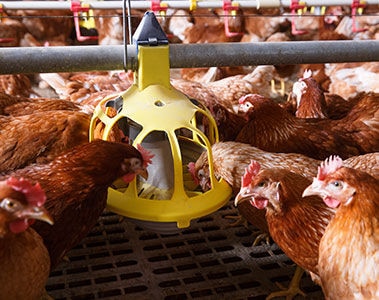
-
Global/EN
- Global
- North America
- Latin America
Vitamin D plays an essential role in calcium homeostasis, bone metabolism, immune function, muscle growth and gene expression. Although animals are capable of synthesizing vitamin D through skin exposure to ultraviolet light; animals housed in confinement or without adequate direct exposure must receive dietary supplements of vitamin D activity. Whether derived from ultraviolet light exposure or the diet, vitamin D (cholecalciferol) is converted in the liver to the main circulating and storage metabolite, 25-hydroxycholecalciferol (25-OH-D3). When active vitamin D is required in the body, it is converted into 1,25-dihydroxycholecalciferol (1,25-(OH)2-D3) in the kidney. A number of other tissues are capable of converting 25-OH-D3 to the active form, including muscle, lymphoid and intestine tissues. As the main circulating metabolite, 25-OH-D3 is the indicator to assess vitamin D status in humans, other mammals and poultry.
In the chicken, absorption of dietary 25-OH-D3 and vitamin D3, takes place in the upper jejunum. The increased intestinal absorption of 25-OH-D3 compared to vitamin D3 is likely associated with the greater polarity of the 25-hydroxylated metabolite, allowing it to be absorbed via non-micelle-dependent transport. This greater efficiency of absorption may contribute to increased circulating 25-OH-D3 status in young birds with limited ability to digest and absorb fat, or birds with impaired liver function compared to those fed vitamin D3.
In young broiler chicks, blood levels of 25-OH-D3 are low following hatch, either due to poor efficiency of fat absorption, limited conversion of vitamin D3 to 25-OH-D3, or a combination of the two. In broiler chicks fed vitamin D3, blood 25-OH-D3 levels decreased from 2 days post-hatch to 6 days, and increased from 10 to 28 days of age, but did not increase between 28 and 41 days of age. When chicks were fed 25-OH-D3 at an equivalent level of vitamin D activity as 25-OH-D3, plasma 25-OH-D3 did not decrease from hatch to 10 days, and the increase from 10 to 28 days paralleled that of the vitamin D3 -fed chicks, but at a higher level. Switching chicks from dietary vitamin D3 to dietary 25-OH-D3 increased, and switching from 25-OH-D3 to vitamin D3 decreased, serum 25-OH-D3. The chicks with the highest level of plasma 25-OH-D3 had the greatest body weights at 41 days of age. Interestingly, the chicks fed 25-OH-D3 from 0 to 41 days, and those supplemented from 1 to 10 days of age had the greatest breast meat yield, suggesting that early supplementation of 25-OH-D3 is crucial.
Providing 25-OH-D3 in the diet eliminates the need for liver conversion of vitamin D, and prevents the reduction in blood 25-OH-D3 during the early part of the chick’s life. In addition, direct supplementation of 25-OH-D3 could reduce some of the negative effects of liver damage that reduces vitamin D metabolism, as occurs with some mycotoxins.
At low levels of supplementation relative to typical commercial levels, 25-OH-D3 exhibits a greater potency to prevent tibial dyschondroplasia in broilers. Importantly, at commercially-relevant levels of supplementation the additional advantages of 25-OH-D3 relative to vitamin D3 also includes increased bone mineralization, breast muscle yield, reduced systemic effects of inflammation (i.e. reduced growth rate following an inflammatory challenge) and increased intestinal integrity. In the studies where plasma levels of 25-OH-D3 have been measured, the supplementation of 25-OH-D3 resulting in these physiological effects also results in an increase in plasma levels of 25-OH-D3.
In published studies in which serum 25-OH-D3 has been measured, dietary supplementation of 25-OH-D3 increases plasma levels accordingly; those increased levels are often associated with increased bone strength, intestinal barrier function, immune function and muscle growth and meat yield. Therefore, on-farm assessment of serum 25-OH-D3 may allow producers to assess whether there is an impaired absorption or metabolism of vitamin D (inefficient absorption, reduced liver function), or whether levels associated with increased physiological function, health and production parameters have been achieved. For such a system to be practical for commercial use, a simple, economical, rapid and accurate test must be available, and clinical serum 25-OH-D3 ranges to achieve various functions need to be established. Currently, blood can be collected on farm using Dried Blood Spot sampling for easy sample collection, storage and transport, followed by liquid chromatography-tandem mass spectrometry analysis. Establishment of clinical ranges upon which to make adjustments to dietary supplementation is underway.
Dietary supplementation of 25-OH-D3 is an effective means of increasing circulating levels of this important vitamin D metabolite in poultry. The ability to assess vitamin D status in commercial poultry in a timely manner that allows corrective action to be taken if necessary can lead to increased performance and bird health.
13 December 2021
Doug is a professor of poultry nutrition at the University of Alberta, Canada. He received a Ph. D. in nutrition from the University of California. Doug’s research program has a strong applied research focus; relevance to the poultry industry remains an important consideration in his approach to research. In addition to practical research on feedstuff quality and dietary supplement evaluation in poultry diets, Doug’s work focuses on nutrition-immune function interactions and bone biology in meat- and egg-type poultry.
We detected that you are visitng this page from United States. Therefore we are redirecting you to the localized version.